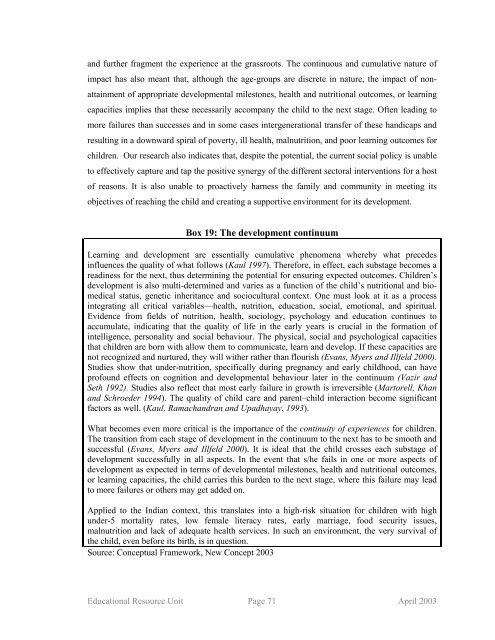Snakes and Ladders - ERU Consultants Pvt. Ltd.
Snakes and Ladders - ERU Consultants Pvt. Ltd.
Snakes and Ladders - ERU Consultants Pvt. Ltd.
You also want an ePaper? Increase the reach of your titles
YUMPU automatically turns print PDFs into web optimized ePapers that Google loves.
<strong>and</strong> further fragment the experience at the grassroots. The continuous <strong>and</strong> cumulative nature of<br />
impact has also meant that, although the age-groups are discrete in nature, the impact of non-<br />
attainment of appropriate developmental milestones, health <strong>and</strong> nutritional outcomes, or learning<br />
capacities implies that these necessarily accompany the child to the next stage. Often leading to<br />
more failures than successes <strong>and</strong> in some cases intergenerational transfer of these h<strong>and</strong>icaps <strong>and</strong><br />
resulting in a downward spiral of poverty, ill health, malnutrition, <strong>and</strong> poor learning outcomes for<br />
children. Our research also indicates that, despite the potential, the current social policy is unable<br />
to effectively capture <strong>and</strong> tap the positive synergy of the different sectoral interventions for a host<br />
of reasons. It is also unable to proactively harness the family <strong>and</strong> community in meeting its<br />
objectives of reaching the child <strong>and</strong> creating a supportive environment for its development.<br />
Box 19: The development continuum<br />
Learning <strong>and</strong> development are essentially cumulative phenomena whereby what precedes<br />
influences the quality of what follows (Kaul 1997). Therefore, in effect, each substage becomes a<br />
readiness for the next, thus determining the potential for ensuring expected outcomes. Children’s<br />
development is also multi-determined <strong>and</strong> varies as a function of the child’s nutritional <strong>and</strong> biomedical<br />
status, genetic inheritance <strong>and</strong> sociocultural context. One must look at it as a process<br />
integrating all critical variables—health, nutrition, education, social, emotional, <strong>and</strong> spiritual.<br />
Evidence from fields of nutrition, health, sociology, psychology <strong>and</strong> education continues to<br />
accumulate, indicating that the quality of life in the early years is crucial in the formation of<br />
intelligence, personality <strong>and</strong> social behaviour. The physical, social <strong>and</strong> psychological capacities<br />
that children are born with allow them to communicate, learn <strong>and</strong> develop. If these capacities are<br />
not recognized <strong>and</strong> nurtured, they will wither rather than flourish (Evans, Myers <strong>and</strong> Illfeld 2000).<br />
Studies show that under-nutrition, specifically during pregnancy <strong>and</strong> early childhood, can have<br />
profound effects on cognition <strong>and</strong> developmental behaviour later in the continuum (Vazir <strong>and</strong><br />
Seth 1992). Studies also reflect that most early failure in growth is irreversible (Martorell, Khan<br />
<strong>and</strong> Schroeder 1994). The quality of child care <strong>and</strong> parent–child interaction become significant<br />
factors as well. (Kaul, Ramach<strong>and</strong>ran <strong>and</strong> Upadhayay, 1993).<br />
What becomes even more critical is the importance of the continuity of experiences for children.<br />
The transition from each stage of development in the continuum to the next has to be smooth <strong>and</strong><br />
successful (Evans, Myers <strong>and</strong> Illfeld 2000). It is ideal that the child crosses each substage of<br />
development successfully in all aspects. In the event that s/he fails in one or more aspects of<br />
development as expected in terms of developmental milestones, health <strong>and</strong> nutritional outcomes,<br />
or learning capacities, the child carries this burden to the next stage, where this failure may lead<br />
to more failures or others may get added on.<br />
Applied to the Indian context, this translates into a high-risk situation for children with high<br />
under-5 mortality rates, low female literacy rates, early marriage, food security issues,<br />
malnutrition <strong>and</strong> lack of adequate health services. In such an environment, the very survival of<br />
the child, even before its birth, is in question.<br />
Source: Conceptual Framework, New Concept 2003<br />
Educational Resource Unit Page 71 April 2003












